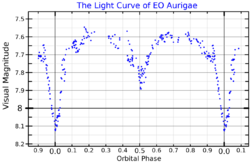Astronomy:EO Aurigae
From HandWiki
Short description: Eclipsing binary star of Algol type in the constellation Auriga
| Observation data Equinox J2000.0]] (ICRS) | |
|---|---|
| Constellation | Auriga |
| Right ascension | 05h 18m 21.06592s[2] |
| Declination | +36° 37′ 55.3517″[2] |
| Apparent magnitude (V) | 7.71[3] |
| Characteristics | |
| Spectral type | B3V + B3V[4] |
| U−B color index | −0.63[3] |
| B−V color index | 0.08[3] |
| Variable type | Algol variable |
| Astrometry | |
| Radial velocity (Rv) | -1.1[5] km/s |
| Proper motion (μ) | RA: −1.67±1.71[2] mas/yr Dec.: −3.33±0.75[2] mas/yr |
| Parallax (π) | 2.12 ± 1.15[2] mas |
| Distance | approx. 1,500 ly (approx. 500 pc) |
| Details | |
| EO Aur A | |
| Mass | 6.22±0.73[6] M☉ |
| Luminosity (bolometric) | 2,784[6] L☉ |
| Temperature | 13,360[6] K |
| Age | 23.6±8.0[4] Myr |
| EO Aur B | |
| Mass | 5.00±2.57[6] M☉ |
| Luminosity (bolometric) | 1377[6] L☉ |
| Temperature | 11,650[6] K |
| Other designations | |
| Database references | |
| SIMBAD | data |
EO Aurigae is an eclipsing binary of Algol type in the northern constellation of Auriga. With a combined apparent magnitude of 7.71,[3] it is too faint to be seen with the unaided eye.
The eclipsing binary nature of the star was detected in 1943 by Sergei Gaposchkin at Harvard College Observatory.[7] It consists of a pair of B-type main sequence stars orbiting each other with a period of 4.0656 days. During the eclipse of the primary star, the combined magnitude drops by 0.57; the eclipse of the secondary component drops the magnitude by 0.33.[8]
References
- ↑ Hartigan, P (January 1981). "A photoelectric lightcurve and elements of the eclipsing binary EO Aurigae". Journal of the AAVSO 10: 13–20. Bibcode: 1981JAVSO..10...13H. https://ui.adsabs.harvard.edu/abs/1981JAVSO..10...13H. Retrieved 29 October 2021.
- ↑ 2.0 2.1 2.2 2.3 2.4 van Leeuwen, F. (2007). "Validation of the new Hipparcos reduction". Astronomy and Astrophysics 474 (2): 653–664. doi:10.1051/0004-6361:20078357. Bibcode: 2007A&A...474..653V. http://www.aanda.org/index.php?option=com_article&access=bibcode&Itemid=129&bibcode=2007A%2526A...474..653VFUL. Vizier catalog entry
- ↑ 3.0 3.1 3.2 3.3 Nicolet, B. (1978), "Photoelectric photometric Catalogue of homogeneous measurements in the UBV System", Astronomy and Astrophysics Supplement Series 34: 1–49, Bibcode: 1978A&AS...34....1N
- ↑ 4.0 4.1 Tetzlaff, N.; Neuhäuser, R.; Hohle, M. M. (2011). "A catalogue of young runaway Hipparcos stars within 3 kpc from the Sun". Monthly Notices of the Royal Astronomical Society 410 (1): 190–200. doi:10.1111/j.1365-2966.2010.17434.x. Bibcode: 2011MNRAS.410..190T.
- ↑ Wilson, R. E. (1953), "General Catalogue of Stellar Radial Velocities", Carnegie Institute Washington D.C. Publication (Carnegie Institute of Washington D.C.), Bibcode: 1953GCRV..C......0W
- ↑ 6.0 6.1 6.2 6.3 6.4 6.5 Hohle, M. M. et al. (April 2010), "Masses and luminosities of O- and B-type stars and red supergiants", Astronomische Nachrichten 331 (4): 349, doi:10.1002/asna.200911355, Bibcode: 2010AN....331..349H
- ↑ Gaposchkin, Sergei (1943). "A New Bright Eclipsing Variable of Large Mass, HV 10327". Publications of the Astronomical Society of the Pacific 55 (325): 192–194. doi:10.1086/125543. Bibcode: 1943PASP...55..192G.
- ↑ Malkov, O. Yu. et al. (February 2006), "A catalogue of eclipsing variables", Astronomy and Astrophysics 446 (2): 785–789, doi:10.1051/0004-6361:20053137, Bibcode: 2006A&A...446..785M
External links
 |


